Rehabilitation and Restoration of Identity-Oriented Values of Traditional Architecture Concepts in Current Architecture in Iran
Masoumeh Amiri1 and Zahra Hasibi2
1
Islamic Azad University Qeshm International,
Iran
2
Islamic Azad University of Bam,
Iran
DOI: http://dx.doi.org/10.12944/CWE.10.Special-Issue1.56
Architecture is undoubtedly one of the most prominent symbols of the civilization of any nation; arrangement type of the buildings and their interior or exterior design has close relationship with the community's culture and economy. Over the past several years, because of social, political and economic changes, many transformations have occurred in the type and residential tissue formation. These changes can emerge in the form of development or decline and death of cities throughout history. concerns of linking with past and fail in creation of a successful architecture process which could be accurately in direction and historical evolution of Iranian architecture value and have a share in contemporary world architecture and even be able to contribute to the advancement of today's architecture. Unfortunately, due to lack of strong link between architects and the exchange of ideas and thoughts, Despite the many common views and opinions of their work can be seen, This process has not yet given form and its theoretical basis is not set. The purpose of this paper is to encourage a return to the old architecture, but the main goal is to recognize architecture of the traditional houses and motivate for proper use of them in modern houses. Therefore, after evaluating the traditional architecture of Iranian houses, and compare it with the modern architecture, we will try to achieve a proper model for revival of concepts in contemporary houses with using of Iranian traditional architectural art.
Copy the following to cite this article:
Amiri M, Hasibi Z. Rehabilitation and Restoration of Identity-Oriented Values of Traditional Architecture Concepts in Current Architecture in Iran. Special Issue of Curr World Environ 2015;10(Special Issue May 2015). DOI:http://dx.doi.org/10.12944/CWE.10.Special-Issue1.56
Copy the following to cite this URL:
Amiri M, Hasibi Z. Rehabilitation and Restoration of Identity-Oriented Values of Traditional Architecture Concepts in Current Architecture in Iran. Special Issue of Curr World Environ 2015;10(Special Issue May 2015). Available from: http://www.cwejournal.org?p=644/
Download article (pdf) Citation Manager Publish History
Select type of program for download
| Endnote EndNote format (Mac & Win) | |
| Reference Manager Ris format (Win only) | |
| Procite Ris format (Win only) | |
| Medlars Format | |
| RefWorks Format RefWorks format (Mac & Win) | |
| BibTex Format BibTex format (Mac & Win) |
Article Publishing History
| Received: | 2015-02-20 |
|---|---|
| Accepted: | 2015-04-20 |
Introduction
Iran has a long history in art of architecture and has a deeply rooted in their belief, values and traditional custom of the people in this country, this Art in the realm of Islamic period, inspired by the Islam’s noble ideas and relying on its own long history experience and use of Muslim beliefs and ideas of architect and artist, Combined is so amazing (Jalili, 2008). Since the time of construction the oldest monument of architecture, Ziggurat ChoghaZanbil which was built 1250 B.C until the threshold of the contemporary period always has an important activity in the Iran architecture and generated valuable and large phenomena in the whole of this land. By a brief review of the historical and formation this house for past till now we find that the inner and the outer space in different historical periods due to a variety of factors such as sovereignty, political, economic and customs. Historical monuments and monumental that are standing have maintained their own ancient times. There are the result of thinks and efforts of our ancestor in centuries. Since the beginning of converting to Islam most of Iranian traditions like architectural traditions that along with the political changes in the countries of the Islamic rulers became popular. Every architectural period has its own significance and implications, such that in comparison with past period still has maintained its own strength and beauty. Ancient times is evidence that development and advancement of architecture in Iran due to this territory one of the first urbanism center in the world is gone that examples include the various monuments and ancient dams and numerous villages all over the country cited. This valuable architecture phenomena are represented the culture and civilization of Iran and Iranian, achievement of many artists who are struggling eagerly with their faith, creativity and perfection of architecture.
Homes as a fundamental place in human and family life have important roles, given the richness of architecture in our country and the architectural researches have done, in the tasks was done still deficiency has seen in this field. Investigation and study of the social, historical, artistic and cultural approach is dangerous and difficult task. This would to enhance the quality and quantity of life in the society and will have fundamental impact. Remembering the past of architectural elements and components in this country considered as the root of culture and values of each nation and emphasis on the promotion and identification of the public opinion is much effective.
In the current society of Iran needs to provide an indicator and taking advantage of this ancient monuments in order to inject in the architectural mind is tangible (Karimzadeh, 2007).After entrance into the modern world Iran architecture, far away from traditional life, in the independence path way from magnificent past of this land and free from constructive knowledge idea of architecture, has taken its steps toward the future with unknown target and therefore in majority cases without knowing the exact knowledge of the theoretical and ideological conceptual in global attitudes, Iranian architecture fall down in a blind imitation and superficiality (Soflayi, 2002).
In this research of qualitative investigate the topic or subject is done from the perspective of history, according to the basement of conception Iran- Islamic architecture, this architecture is at a distance of fifty years of contemporary era, the days of dealing with modern ideas till now, under rapid expansion and unorganized global communication is going to be analyzed.
Reason of Choosing the Topic and Methodology of Research
Investigation and study of the social, historical, artistic and cultural approach is dangerous and difficult task. This would to enhance the quality and quantity of life in the society and will have fundamental impact. Remembering the past of architectural elements and components in this country considered as the root of culture and values of each nation and emphasis on the promotion and identification of the public opinion is much effective. Gradually in the current society of Iran the housing is losing its real meaning, needs to provide an indicator and taking advantage of this ancient monuments in order to inject in the architectural mind is tangible. The present Investigation seeks to answer the fundamental question that how the principles of traditional architecture used to improve the environment of contemporary architecture and on this basis to explain and determine the principles of traditional Iranian architecture in order to improve the design principles of modern architecture houses formed and the basic hypothesis examined in this investigation, is the identifying the principles of Iran traditional architecture that can be improve in order to extend the usability of the house’s environment to reply. This study due to the fundamental nature is analytic-descriptive and use and study of relevant references and library studies completed.
Main Cultural Foundation in Traditional Architecture of Iran
Surely, culture factors are one of the most important and effective in order to the perception of architectural environment, because of its effects is shown in individual and social life. Spencer in his sociology book has called culture as an element of the physical. May be argued that culture has no any theoretical aspects and transmitted from generation to generation, its elements are accumulated and is published from one place to another, comes to the selection and can find professional aspects with certain types of split and finally be undergoing a crisis. Knowledge and habits are acquired by man through this way, concluded his knowledge and personal experience that confronting with architecture area, by remembering that, analysis of new area by whatever they already have in their mind, all parts, elements and spaces that have reached the realm of immortality would have nameless quality (Pirnia,1988). Nameless quality in Iran- Islamic traditional culture has arisen from many factors that the most important is transparency, identity, stability, durability, harmony, unity and discipline. Architecture area and natural environment, totally understandable relationships among the points and their location that is, the concept of city so that in the flowing part a few general concept of quality briefly presented.
Durability
According to link durability is “The resistance rate against exhaustion and deterioration of the city and having the ability to operate over a long period”. Totally space has the time which is overall the present and people like to experience it and embrace more impact from space. Durability is a kind of historical continuity and following cultural continuity. Durability joins past and presents history together and will lead to personally identify.
Stability
The reliability or stability in the sense of something that remains fixed in place. Sustainable phenomenon caused by the durability of the model, the methods or system during the time is longer. So we seek for a pattern in Iranian- Islamic architecture, the pattern or a model which we could build a sustainable architecture not a memorial one; because in this case the phenomenon or its all features of the material and immaterial won’t be remain in itself, but also in each period based on a pattern which repeat and get continuity in this way. In this repetition and the repetition again at any time try to modify and fit more with the surrounding circumstances in this case. In the stability of the survival and development, there is stability for the coherence of the ability to grow an inherent tension, the reliability is for the phenomena that can improve balance and apply for the mutual relationship.
Introversion and the Central Courtyard
In the traditional Iranian architecture, buildings built adopted as traditional form and tradition around the interior space shaped and was called and looked introverted so that in this state factors such as climate, location, area, are affected by social and cultural factors. One of the characteristics of the introverted house can inform that having no direct visual connection to the outside spaces within the urban spaces and spaces also exist, including the central courtyard and covered platform pointed so that the holes and the openings are open to the elements (Figure 1).
Courtyard as the main outdoor, representative coexistence with nature and in the historical and traditional country houses, micro-climate and the small garden house is considered. In the historical house, yard was built at the center and played important act like a heart; in this house yard is like for privacy acquisition, integration of elements of the house, creating a green and fresh environment, and finally the safety and convenience of the family was quiet. Existence of the sunken garden with a variety of flowers and trees and sometimes shallow pool or pond in the central of monuments courtyard, in addition to the beauty, by ghosting and increased relative humidity contribute to the comfort the courtyard environment (Haeri et al., 2008) (Figure 2). The size of courtyard was also designed to be capable in the cold winters, with solar radiation, resulting in a moderate climate in the interior of the house.
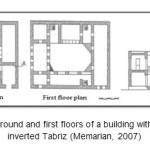 |
Figure 1: Plan of the ground and first floors of a building with a traditional structure inverted Tabriz (Memarian, 2007) Click here to View figure |
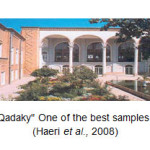 |
Figure 2: The house of "Qadaky" One of the best samples of traditional architecture (Haeri et al., 2008) Click here to View figure |
Vegetation and Green Space
Planted associated with traditional buildings, it must be said that the plants in the water evaporates, causing humidity In the In the environment have a significant impact. Generally trees and plants adapted to the climate of the historical houses areas, in addition to increasing relative humidity, shadows in the summer were caused. As an example Existence of a large courtyard by a large pool and garden long and wide around the pond and planting flowers and plants(Figure2), caused to damp weather decrease the temperatures in the outer of enclosure the house and reducing the temperature of the interior space sectors have redundancy influenced. On the other hand the trees, besides of preventing wind and dust reduction, transmission of sound and air purification, could have a great effect in moderating the temperature swings and provide suitable conditions for life in this region.
Building Form
One of the most important methods establishment building sob serve for the directions which itself rotation of the sun and its light in the different seasons has closely associated. On the other hand existence of damaging winds in some area, the principles and orientation of the buildings will be doubled (Akhtarkavan, 2007). In the Iran’s traditional architecture sometimes courtyard is in one side direction and also often is in double side this means that the existence of a yard in front of sun for the winter, backside to sun in order to applicable for the summer(Figure 3).
In the traditional house in order to protect rooms from the cool of winter all windows are built in doubled forms, two windows were used to (that the inner window opened into room and others opened outside) (Figure 4,5). As an example in the fundamental traditional house in cold climate, cold climate caused compression in the building form and the intensity of sunlight caused expansion east- west side. Also it should be consider that the best form of construction buildings in such climate, that despite highest volume it was square plan, which has the lowest surface and also has the minimum amount of heat exchange in different seasons (Kasmaee, 2002).
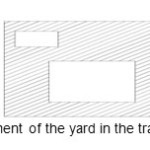 |
Figure 3: arrangement of the yard in the traditional architectural Click here to View figure |
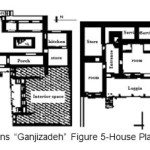 |
Figure 4: House Plans “Ganjizadeh” Figure5: House Plans “Ghazi TabaTabei” Click here to View figure |
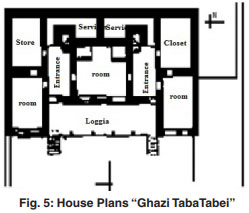 |
Figure 5: House Plans “Ghazi TabaTabei” click here to view figure |
Including features of traditional architectural monuments in the Iran’s traditional architectural can point the following items which are prepared stable condition for the similar life:
- Completely introverted and enclosed
- Buildings have central courtyard, porch, underground
- Floor (especially yards) lower than surface of the passages
- The rooms are relatively a short in height and the walls are thick
The Identity Elements of the Traditional Houses
Traditional architecture in Iran has a long history experience and at the anytime capable hands, creative mind, the patrons of art stylish in this land, has brought dramatic phenomena, so that in many cases are the principles and as the basement of architectural art became Identified in the universe. Some of these phenomena in the round of enormous Iran have a story of the magnificent architecture of the Millennium cycles. In the traditional architecture of Iran the buildings have formed according to culture and personality and never composition and architecture of building have been contrast to cultural and religious beliefs of the people in that area. Even the decoration was used in subsidiary organs were not exception from this system. In this building, while maintaining cultural identity in construction five public stylish principles such as avoiding futility, introversion and usage of materials were observed. Another feature of these houses is the center of reflection. In the Iranian houses religious, economic and social concerns were noted and to provide of each needed adequate spaces with best shape were used. An Iranian house can be considered in building square complex that surrounded by yard and adequate space. The garden is the central place in Iranian traditional houses; Pond, flowers, trees found in most houses, closed places that surrounded courtyard by the five and three doors and halls, which were getting the light through colored windows or opening. One of the Iranian favorite in construction action house was built communication system between the rooms and outside spaces; wide extension, spacious and open vision view are the nature of Iranian, even now in some contemporary that futures can be seen, in such method the privacy included in Iranian traditional architecture and the outer walls of the building have no windows to allow direct view into the house is possible. These walls were decorated by arcades and Congress, and the entrance was just only opening of the building (Memarian, 2007). Another features of these houses are linked architecture with nature. Sympathy and respect to nature has deep in culture and peaceful coexistence humans and nature is obvious in the Iranian traditional architecture. In the Iranian architecture the presence of nature are unified and Semi-closed semi-open spaces in the hierarchical process placed together as though they always had the motivation to respect and pray the God. Excellent example of this feature is “HashtBehesht” in Esfahan (Figure6-A). Whenever we pass through different levels, nature and the shear of heaven is nearby with us in the different angles and the inside and outside conflict such as the circulation of the days are shown the images that its elegance, peaceful or silence of the nature are guide us to pray and imagine the dimensions and the extent of the world. Overall geometric axis of the “HashtBehesht” has caused the upper levels are always run around the central unite and the illustration in the part and the whole of nature is present. As same as all area in Iranian architecture, passing through the space (room) to another space by using the median (joint) occurs.
The more complex patterns that organize the entire building are also known to follow certain by laws. The courtyard as a central core(Figure6-B) of a group or collection and the organizing factors, in combination of simple and compound forms in combination of simple and compound forms, is one of the most general characteristic patterns in the types of evidence that can be varied. Also the courtyard is seen at the contemporary house; with this difference that in the traditional house, courtyard is in the safety and comfort of the house has held played an important role. However, such a role is not present in the house. Houses were built in that rooms surrounded the yard and the walls throw shadow on yard. In the Iranian architectural factors such as: optimize usage of available space, the proportion of local materials with climate, protect or prevent hot and cold, the solar radiations and suitable lighting and even issues such as echo, wind direction and air flows inside the building or kiblah professionally considered (Pirnia, 1998). However, nowadays being a yard at the building and its role became fade.
Terrace is one of the important and specific parts in Iranian architecture considered with semi-open and semi-closed, that is one of the beast attitude and symbiosis with nature. Set aside from the perspective of a calculated image, Presence of terrace covered the median lighting (lighting) and it is a connector between outside and inside space that is effective to adjust air quality of the weather.
In the traditional houses, there was a middle vestibule and inductor which regulator of visible view and the relation between outside and inside of vestibule, such as the terrace location between the inner and central space. The other contents, the porch shapes hall in the traditional houses which taken specific shapes by the geographic aspects and winter, summer that benefited them around the rooms.
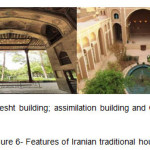 |
Figure 6: Features of Iranian traditional houses Click here to View figure |
As another example, the inner house has built Pre-Islamic, that is a sample of Iranian traditional architecture. These houses do not have a visual direct connection between inside spaces within the urban environment. Also different spaces have been organized such as courtyard and covered platform. So that opening holes and the openings are opened into this unit. The architecture of the houses private or public life has its own beauty, by means of simple elements such as front, entrance, drums, vestibule, and hall, kitchen, has separated from each other (Qiyasvand, 2005).
Iranian Non-Identity in the Contemporary Architectural Elements
During many years numerous changes occurred in our technological and cultural and effected many aspects in the life of human. These physical and conceptual changes from yesterday until today has caused occur many changes in the appearance of the houses and on the other hand the inner spaces that changes in the physical geometry of houses and changes in the necessity rate of space and changes in infrastructure and the size of land, low population in the families and desire to independent life and many other reason that each in its turn had a significant role in the changes including them. Generally the pattern of Iranian contemporary houses is superficial and most of them dealing with by square meters and based on the range and size of the functions and made in order to meet human necessity needs (Haeri, 1995).
Our modern homes sometimes even in the Supply of the most basic requirements of living like provide relaxation and physical comfort generally have been unsuccessful inducing quality demands. The Iranian the old house have place and space where residents were belong to them, these houses reflect the principles that are consistent with the internal states of human life and its structure was appropriate to the beyond life. There was a real sense of living in these houses. However, Iranian contemporary houses are deprived from this feature and have less variety and additionally this verity is just seen in color, facade or the amount of light or levels. Also, occasionally the lack of space and closed space has seen on very contemporary houses that this matter caused to be separate spaces by putting objects between the posed (Figure 7).
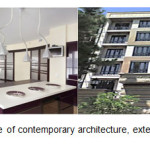 |
Figure 7: An example of contemporary architecture, exterior and interior house Click here to View figure |
Describe Features and Characteristics of Spatial Pattern in the form of Contemporary Houses
In the early twentieth century, construction of residential buildings over, both shapes and contrasts of designing the new residential buildings in how people live as well as one of the form of building, clearly display the lack of homogeneity of the urban environment and social welfare demand. Such a situation in the face of architecture major cities in Iran was Visible(Figure 8).
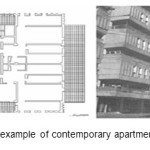 |
Figure 8: An example of contemporary apartment architecture Click here to View figure |
After the years 1300 calendar, changing the form of economic development, a number of problems bring along with its historic towns. Hasty function and non-academic extensive context of residential areas has formed. Designed with different modes of architectural non-identity was provided. it is necessary be noted that the lack of a comprehensive plan in urban development can be considered as a result of these crisis. After the years 1320 because the middle class of financial resources, all kinds of residential buildings to see villa houses that each of them obey any kind of architectural as a result of the disordered architecture, so that develop any kind of non-identity; Although these components are not non-identity, in total it has no order and do not belong to any period of history. The city would change to disparate pieces are stick together be converted to a different style of each piece. Wanted modern architecture, transmits east culture inject to the inner of Iranian society. Although contemporary architecture of Iran is much admirable in the form of individual and artistic creative, it has never able to change from individual form to collective forms (Haeri, 2008).These changes in the spaces organization of house space and have occurred in the lifestyle of family that might be now a day’s houses in the comparison by a half century ago house could not call an Iranian house (Qiyasvand, 2005).
Comparative Analysis of the Spatial Relations with the Historical and Contemporary Iranian House
All the houses built in the year 1300, either small or large, have yard or central yard and arrangement set of around the yard has followed certain and specific order. The oldest, most prestigious and the most enduring pattern of the popular area organization in the houses are the model of room, terrace and the yard (Haeri, 2005). In this model, there are three different spatial resolution in the terms of welfare, climate, nobility, and the variety of public and private realms (Open, Closed, Covered) which was designed as an extension of each other. All three types of living spaces are useable and can use them as separated and also combined them. The design of these houses, and the life style in its most extensive aspects and included the area organization of the smallest to the largest scales. Area organization of the historic houses for the requirements and life style changes was very flexible. Each space in the house while independent was not restricted; it was possible to combine with their surroundings (Christopher, 2010). Now to specify of the living condition and climate that are influenced by the culture in the historic houses, started to analyze how the condition and climate are established in the environment and how their connection between the spaces has been done.
The main and principle characteristic of the historic house that made them different and distinctive with contemporary house are the following aspects:
- Activation the method of the spaces in historical houses
- The area organization in the historical houses in order to use the open, covered and closed spaces and the air convection at the inside of building and making shadow and establishing the pool in order to surface evaporation and meet the requirements of energy saving is replay to provide welfare.
- Comfort- causing factors such as windward, basement, shadowing, pool, garden, all together located in the organized area and display architectural features.
- The Variety of Indoors and Closed Spaces in the Historical Houses
- Indoors and closed spaces based on a defined scale from small to large which is consistent with the lifestyle needs.
- Possibility to extension the indoors spaces to each other, such as extending the closed area into open and covered area in the system of designing historic houses.
- Dynamic and Mobility of Living Space with Nature in the Historic Houses:
- The historic houses are not separated from nature and presence of nature in the house is essential
- House area organization and the direction of wind and sun, season rhyme, water and etc… to create welfare and take advancement by providing the definition of architectural element to merge them.
- Dynamic Spaces of the Private up to Socialize in Historical Houses
- Type of scale component of various paused areas (two-door, three-door, five-door, etc.) and also their position in the area organization of the bottom house, up to upstairs and etc……. Possibility to access to various spaces in the private realm up to provide public.
- Covered areas between open and closed, corridors and doors in historical houses act as space boundaries. The old way of life style and housing properties in Tabriz, both private and closed space is included, but in the modern age habitat is called the inner of the house. Space organization of an apartment (current houses) is consists of a closed and an open section where the outdoor (yard) is placed against the closed section. Closed section, is a result of putting many cubes together and the possibility of expanding the space and create a variety of spaces per habitation does not provide the elevation of the part. The only direction for the inner space per habitation of developing remains along the horizontal axis of the cube which is also thinking as a box orientation inside the area organization has become pale.
The Main and Principle Feature of Modern Housing Can Pointed to the Following Aspects
- Activation the Method of the Spaces in Modern House
- Responsibility for providing comfort- making is out of area organization of the modern houses.
- In the modern house the area organization there is no response to harmonic with the nature and no changes and the technology has replaced insist of area response at the divergent directions.
- The Variety of Indoors and Closed Spaces in the Modern Houses
- Closed spaces in the modern houses are in two separated and tangled sections.
- The possibility of combining closed section each other is very low. The dominate tendency for designing modern houses, caused an increasing closed placed in the shapes of bedroom.
- Dynamic and Mobility of Living Space with Nature in the Modern Houses
- The house area organization is unconsidered to the nature. It has not fulfilled of the comfort- making facilities for the household.
- Presence of the nature in the modern house is restricted and semi limited.
- Dynamic Spaces of the Private up to Socialize in Modern Houses
- Considering the possibility of combination separated areas and no provided and extension spaces, the house environments has been divided into parts such as public and private sections.
- Rooms which are the delegated of private sections in the residential spaces, will be re-connected to the outside. Crowded spaces, privacy interference and contamination eliminate the possibility of privacy.
The Important Points for Rehabilitation and Restoration of Traditional Architectural Identity in the Continuation of the Principles of Design in Modern Architecture:
- The concepts of principles architecture factors along with the culture history of land transfer and extends them.
- The form of culture is produced by the following environmental features and philosophical properties and that the time factors has created new shapes of the spaces, as the principle factors due to inherent and the nature of the human life changes.
- According to the principle of stability concepts inherent origin of any phenomenon, it can be possible preserved humanitarian principle properties during of the timeand used them as a fundamental concept and inspiration properties.
- In the term of addressing and dealing with the architecture, it doesn’t mean that the fundamental and necessary aspects imitation from foreign cultures in the science of philosophy and logical orientation.
- The valuable art does not involve by the imitation, and the phenomenon or the arts that do not have any innovation or creativity in its time, undoubtedly has no any valid value and won’t be help full in any way.
- There is no form of cultural concepts for inversion and in order to achieve excellent and noble goals by utilizing the improvement and promoting the art of architecture of a land.
- The forms have a concept of semi logic and symbolic and building are combination of architectural elements, can’t be run out of Culture cognitions and abstract movement.
- The experience modern art and architecture (international) is disconnecting the relation between the environment, history and tradition, and a clear indication of a failed experience in which that the innovation has been ignored.
- The architecture has two main principle aspects of cultural and scientific, and whenever in the course of time, one of these aspects is weak, the result is became insufficient and incomplete development. In this field (architecture), engineering and innovative sense are the two main wings of invented and creation in the art and considering to both (engineering and innovative) and controlling and dominate are the basement of these science of art and should always be consider in the designing.
- Today's architecture is considering the modern ideas and join to the international community needs to adopt new approaches. What should never be forgotten, knowing the values embodied in the architectural tradition of these land, a tradition that the sign of high culture of Iran in which has a brilliant record. In this context it is necessary to considering the following properties:
- Trying to modify the structure of the construction in the field of professional architecture in contemporary particular look at and not quick and authentic traditions of Persian architecture
- Trying in order to restore the proper method of construction in the country in which that appropriate by the Iranian architectural values in the past.
- Trying to use optimize of the existing facilities that fits on updated improvements in the contemporary world in order to improve both education field and professional....etc.
Conclusion
Using architectural achievements of the past can assist us in the present and future architecture. Most of satisfaction from urban area in our country can be removed by utilizing the advantage of the skills and ideas of the architectural predecessors. Values and powers such as naturalism, local knowledge and energy saving in the construction of the historical houses, not only disabled and useless, but considered a fundamental require in the present and as in the construction of the modern houses. Iranian traditional houses are considered as a dynamic building, because their needs to water and energy were provide by them self and not only adopted and compatible by its own constriction and climate, but also knows themselves in sharing by the environmental changes. Furthermore, works without pollution and do not make any damages that may be harmful to other types of contraction processes or don’t make any damages that is not use as directly in the environment. In Iranian local architecture all stable principle factors of architect that led to construct the whole process, existed in order to create safe environment and interact dynamic equilibrium with each other. From networking and blocking the cities till constructional units, from Figure and fragment size of land to construction techniques, all in whole create a collection that can be defined unified and cohesion. This designing of harmonic by the climate of Iranian traditional architecture in the past decades, it can still be model for nowadays constrictions. Of course, this is not meaning that return to the past; because if somehow the designing return to the past, except imitation nothing can get and on the other hands understanding of the past, it is not to return, but at any time should move towards the development, try to learn any aspects of logical forms and traditional methods in order to apply them with today building requirement. Nowadays cannot live in the style of the ancients and this is a reality fact of life, but it is possible use the same techniques, method sand concepts and then combining them by the modern style to advance the identities and culture in today's houses, this means that identities and science should develop together. Designers, architects and urban authorities should consider and pay attention to the design of urban spaces with appropriate to the culture and custom and geographic requirements of that area so that apply them in the designing urban spaces. Whatever today’s architects as the past heritage can get benefit from it, considering to the types of the phenomenon attitude, in the concept of human and house, in this case is certainly the result works will be familiar by the space architecture. Space that deeply with us, grow within and our culture is mixed in them.
References
- Alexander, Christopher, architecture and the secret of immortality (the timeless building), translated by M. Qayyum Bidhendi, with the introduction of Mehdi Hojjat Beheshti University Press (2010).
- AkhtarKavan, M the crisis of contemporary architectural thought, Journal of Architecture and Building, page 35-32 (2007).
- Ghobadian, V..Evaluation of traditional structures climate Iran, Publication of Tehran University, Fifth Edition (2007).
- Haeri, Mazandaran, Reza, based on the findings of the study and application of traditional architectural design, modern housing, village magazine, No. 23, Tehran (1995).
- Haeri Mazandarani, Reza, housing, culture, nature, explore historic homes and contemporary to develop a process and criteria for the design of the house, Tehran, published by the Center for Studies and Research Planning and Architecture (2008).
- Jalili, T., body and spirit footprint area and the veil of Persian architecture, the National Conference on Women and Architecture (2008).
- Karimzadeh, Jamshid, lasting treasure of architectural masterpieces in History, Master's Thesis (2007).
- Kasmaee, M..Climate and architecture, the company's investment in housing (2002).
- R, GH, Iranian architecture, publishing Soroush knowledge, the first published (2007).
- M, search in Iranian past architecture, Tehran university publish institute (1998).
- Qiyasvand, J.. Interaction of Architecture and Renewable Energy (stable) College of Civil Engineering, No. 38 (2005).
- Soflayi, farzaneh, stable elements of the traditional architecture, to optimize fuel consumption on the premises Conference Proceedings, Volume 1, (2002).







